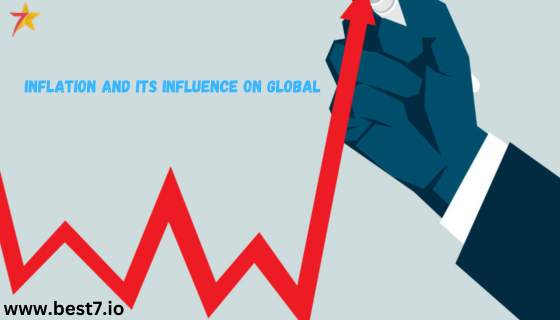
Inflation has always been a critical issue for global supply chains, and the rising costs of materials and logistics create a series of issues for companies that can only be overcome with adaptations. Reviewing the case studies and trends, it is possible to define how inflation impacts various types of companies and recommend strategies to help them stay afloat. This essay shows that adaptation to inflation is a significant challenge for modern companies, pushing them to develop multiple strategies to minimize this impact. The intent of this assignment is to prove these points and provide recommendations.
The Economic Impact of Inflation on Supply Chains
The last couple of years saw inflation rates rise consistently, reaching levels not seen for several decades. This shift has impacted global supply chains; for example, in the USA, the inflation rate was approximately 7% by the end of 2021 due to supply chain disruptions and increased consumer demand. These factors have driven drastic cost increases across multiple industries, necessitating new supply chain strategies.
Key Areas Affected by Inflation
- Cost Increases: The ongoing inflation process means that more businesses report serious cost increases. Logistics costs rose by about 20% by the end of 2021, impacting overall profitability and driving changes in pricing strategies.
- Production Delays: Shortages of materials are a common issue leading to production delays. By 2022, 30% of manufacturing companies experienced longer lead times and challenges in meeting customer demand.
- Transportation Costs: Freight rates increased by three to four times in some cases, worsened by shifts in last-mile delivery patterns.
The points above clarify how inflation affects different economic sectors, creating specific challenges for the modern economy.
Demand Fluctuations and Consumer Behavior Shifts
Inflation triggered fluctuations in demand as consumers adapted their shopping behavior in response to rising prices. Late last year, a global survey revealed that 60% of consumers planned to reduce discretionary spending, prompting companies to adjust inventory management based on new consumer priorities.
Strengthening Supplier Relationships
Inflation has increased prices and worsened supply delivery times, pushing firms to reconsider supplier relationships. Establishing long-term relationships or joint ventures with suppliers became standard, providing a more reliable supply chain.
Inventory Management in an Inflationary Environment
Effective inventory management has become critical due to inflation. Companies need to optimize stock levels to match current prices while maintaining sufficient inventory to meet demand. By 2023, 50% of firms were expected to transition to just-in-time inventory practices.
Impact of Trade Barriers on Inflation
The inflationary environment has also been influenced by geopolitical and economic tensions, leading to heightened trade barriers, which may further affect supply chain dynamics in the coming years.
Resilience Strategies in Supply Chain Management
Companies are implementing various strategies to manage rising costs and operate in a stable environment despite inflation.
- Strategic Sourcing: Strategic sourcing has become a significant trend, with an estimated 70% of companies expected to adopt this approach by 2025 to optimize purchasing decisions.
Impact and Response of Inflation on Global Supply Chains
- Price Increases: Inflation has led to increased raw material and transportation costs, making supply chain management more expensive. By 2025, companies are projected to increase their spending by 20%, with some absorbing costs, negotiating with suppliers, or marginally increasing product prices.
Scenario Planning for Inflation Management
Inflation has heightened the importance of scenario planning in supply chain management. Studies estimate that by 2027, 60% of companies will conduct scenario planning exercises to manage risks associated with supply chain disruptions.
Future Steps for Managing Supply Chains in Inflationary Conditions
- Diversification of Suppliers: Companies are increasingly diversifying suppliers to minimize reliance on a single source. By 2026, 60% of companies are expected to have diversified their supplier base.
- Investment in Technology: Many businesses are integrating technology into supply chain management. By 2027, technology investments are projected to increase by 25%, focusing on automation and real-time data analysis.
- Enhanced Logistics Planning: Logistics planning is essential for cost-effective transportation. By 2028, 40% of companies worldwide are anticipated to adopt better logistics strategies.
- Flexible Production: High inflation influences purchasing behavior, so by 2025, about 50% of companies will switch to agile production models to maintain flexibility.
- Collaborative Supplier Relationships: Collaboration with suppliers has become vital in mitigating inflation’s effects on supply chains. By 2026, half of all firms are expected to strengthen these relationships.
The Future of Global Supply Chains in an Inflationary Environment
Inflation will likely continue to impact international supply chains, requiring global businesses to coordinate complex strategies to avoid long-term repercussions.
Economic Conditions and Their Role in Shaping Supply Chain Strategies
By 2025, economic conditions will likely stabilize, helping supply chain strategies adjust accordingly. Expected economic growth stabilization of approximately 2.5% annually could improve awareness of supply chain challenges.
Increased Focus on Sustainable Practices
In the coming years, sustainability will be a major focus for supply chain management. By 2026, 70% of businesses are projected to adopt sustainable practices, addressing both environmental concerns and cost management.
Balancing Globalization and Localization
The debate over globalization versus localization continues, with about 40% of companies projected to adopt hybrid sourcing models by 2028. This shift will enhance resilience by combining global sourcing and localized production.
Building Resilience and Adaptation
Ultimately, success in an inflation-prone world will depend on a company’s ability to adapt and build resilience within its supply chain management practices. Predictions suggest that by 2027, about 80% of companies will prioritize resilience to withstand various economic conditions. The more resilient strategies companies implement, the better prepared they will be for challenges, including inflation.












